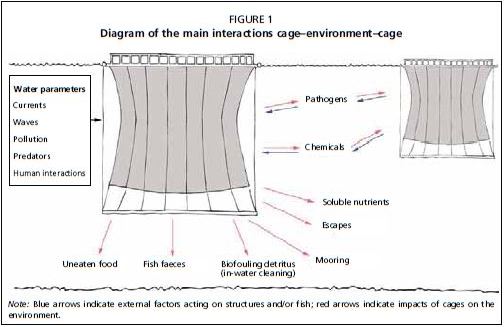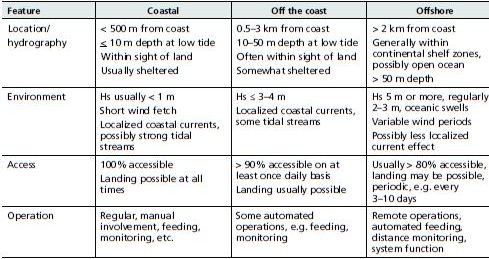2. Site selection
Cage culture refers to an open aquaculture system where the rearing environment is the environment itself. As such, there are interactions between cages and the environment in both directions – cages affect the environment, and vice versa.
Moreover, one cage can have impacts on other cages because currents can transfer pests, pathogens and chemicals from one cage to another (or from one site to another).
Within the site selection process, all possible interactions and their impacts on the cage aquaculture, including both environment and human related, should be evaluated and assessed in order to minimize threats, hazards and overexploitation (Figure 1).
Choosing a site in any fish farming operation is crucial because it influences economic viability. Site selection directly affects running costs, production, mortality and overall profitability. Compared with a land-based facility, sea cage aquaculture has less room for error regarding site selection, particularly as a wrong siting may result in the loss of the fish stock and cages.
A first general site characteristic is its exposure. This refers to the amount of wind and waves to which the site is subjected. An offshore and exposed site location will mean higher initial investments for cages, moorings and nets, higher costs of maintenance and greater risks, resulting in greater production costs. On the other hand, an exposed site will have a better hydrodynamism, with a resulting lower environmental impact, better fish welfare and a better product quality. A sheltered and protected site will be less exposed to waves and currents, which implies reduced maintenance and costs, but higher risks of significant environmental impacts are often associated with more sheltered sites for these very reasons.
Site exposure classification between offshore and nearshore is highly debated, and several definitions of offshore cage culture have been proposed so far. Some of these classification schemes are included in the following tables. Table 1 presents a classification proposed by FAO in 2009.
FIGURE 1
Diagram of the main interactions cage–environment–cage

TABLE 1
Site classification proposed by FAO in 2009

Note: Hs = Significant wave height (Hs x 1.9 = Maximum wave height).
Source: Lovatelli, Aguilar-Manjarrez and Soto (2013).
Table 2 provides another possible classification, adapted from the Norwegian Standards (NS) NS9415-2003 on “Marine fish farms requirements for site survey, risk analyses, design, dimensioning, production, installation and operation”, which is based on significant wave height (Hs), peak wave period (Tp) measurements and degrees of exposure. The sites are ranked from A to E, where A refers to sheltered sites and E refers to very exposed, offshore sites.
TABLE 2
Norwegian site classification based on statistical parameters of waves

An additional possible classification (Table 3) proposed within the Norwegian Standards is based on the mid-current speed (Vc). Wave classes at the site are determined by metrics of significant wave height and wave period
TABLE 3
Norwegian site classification: based on mid-current speed

A further example of classification (Table 4 and Figure 2) was proposed at the “Farming the Deep Blue” conference held in Dublin, Ireland, in 2006. Here, the farm sites are classified into four classes where the exposure levels are matched with the cage technology used/recommended. In 2009, the Norwegian Standards moved to a similar classification scheme that considers the type of cage as well as the environmental conditions.
TABLE 4
Marine cage site classification proposed at the “Farming the Deep Blue” conference

The site classification examples provided above show how the classification of the site can be assessed using different considerations and objective observations, but that classification may differ depending on the method applied. In the end, exposure (and, consequently, current and wave height) is certainly the most relevant factor to be considered in offshore site classification regardless of the actual distance from the coast.